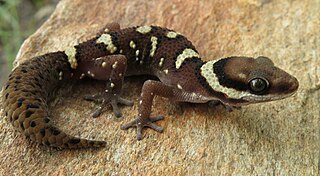
Lygodactylus is a genus of diurnal geckos with 82 species. They are commonly referred to as dwarf geckos. They are mainly found in Africa and Madagascar although two species are found in South America. Lygodactylus picturatus, the best known species, is found in Kenya and commonly known as the white-headed dwarf gecko. Recently, illegal importation from Tanzania of brightly colored, Lygodactylus williamsi, known as electric blue geckos, has been gaining attention for Lygodactylus geckos in the reptile trade.

Pachydactylus is a genus of insectivorous geckos, lizards in the family Gekkonidae. The genus is endemic to Africa, and member species are commonly known as thick-toed geckos. The genus also displays rich speciation, having 58 distinct species identified when compared to other closely related gecko genera like Rhoptropus, most of which have emerged since 35Ma. It has been suggested that the reason for this rich speciation not from adaptive radiation nor nonadaptive radiation, but that the genus represents a clade somewhere between the two drivers of speciation. P. bibronii geckos have been used by NASA as animal models for experimentation.

Acontias is a genus of limbless skinks, the lance skinks, in the African subfamily Acontinae. Most are small animals, but the largest member of the genus is Acontias plumbeus at approximately 40 cm (16 in) snout-vent length. All members of this genus are live-bearing sandswimmers, with fused eyelids. A recent review moved species that were formerly placed in the genera Typhlosaurus, Acontophiops, and Microacontias into this genus, as together these form a single branch in the tree of life. This new concept of Acontias is a sister lineage to Typhlosaurus, and these two genera are the only genera within the subfamily Acontinae.
Lacertaspis is a genus of skinks endemic to Central Africa.

Trachylepis is a skink genus in the subfamily Mabuyinae found mainly in Africa. Its members were formerly included in the "wastebin taxon" Mabuya, and for some time in Euprepis. As defined today, Trachylepis contains the clade of Afro-Malagasy mabuyas. The genus also contains a species from the Brazilian island of Fernando de Noronha, T. atlantica, and may occur in mainland South America with Trachylepis tschudii and Trachylepis maculata, both poorly known and enigmatic. The ancestors of T. atlantica are believed to have rafted across the Atlantic from Africa during the last 9 million years.
Fritz Nieden (1883–1942) was a German zoologist who specialized in African herpetology.

The Annobón lidless skink is a species of lidless skinks in the family Scincidae. The species is endemic to the island of Annobón in Equatorial Guinea and is listed as critically endangered by the IUCN. The species was first described as in 1972.
Lacertaspis chriswildi, also known commonly as Chris Wild's snake-eyed skink, Chris-Wild's snake-eyed skink, and Chris-Wild's lidless skink, is a species of lizard in the family Scincidae. The species is endemic to Cameroon.
The short-headed snake-eyed skink or Peters's lidless skink is a species of lidless skinks in the family Scincidae. The species is found in western Africa.
Panaspis burgeoni is a species of lidless skink, a lizard in the family Scincidae. The species is endemic to the Democratic Republic of the Congo.

The Cabinda snake-eyed skink or Cabinda lidless skink is a species of lidless skinks in the family Scincidae. The species is found in the Democratic Republic of the Congo and Angola.
Panaspis maculicollis, also known as the speckle-lipped snake-eyed skink or spotted-neck snake-eyed skink, is a species of lidless skinks in the family Scincidae. The species is found in southern Africa.
Panaspis massaiensis, also known as the Maasai snake-eyed skink, is a species of lidless skinks in the family Scincidae. It is found in Kenya and Tanzania. Until its revalidation in 2019, it was considered of synonym of Panaspis wahlbergi.
Panaspis megalurus, also known as the blue-tailed snake-eyed skink or Nieden's dwarf skink, is a species of lidless skinks in the family Scincidae. The species is endemic to Tanzania.
Panaspis seydeli, also known as the Seydel's snake-eyed skink, is a species of lidless skink, a lizard in the family Scincidae. The species is known from the Democratic Republic of the Congo and Zambia.

Panaspis wahlbergii, also known commonly as the Angolan snake-eyed skink, the savannah lidless skink, and Wahlberg's snake-eyed skink, is a species of lizard in the family Scincidae. The species is widely distributed in Sub-Saharan Africa. However, it likely represents more than one species.
Panaspis wilsoni, also known commonly as Wilson's dwarf skink and Wilson's snake-eyed skink, is a species of lidless skink, a lizard in the family Scincidae. The species is endemic to Sudan.
Panaspis annettesabinae, also known as Sabin's snake-eyed skink, is a species of lidless skinks in the family Scincidae. It is endemic to Ethiopia. It is known from certainty only from its type locality near Bedele in the Oromia Region, southwestern Ethiopia, although there is a tentative record from central Ethiopia.
Panaspis ericae is a species of lidless skinks in the family Scincidae, native to Africa. It was first discovered in 2022 in Angola. It is named for Erica Tavares, an Angolan conservationist and biologist. P. ericae has a coppery-brown appearance and robust body.







